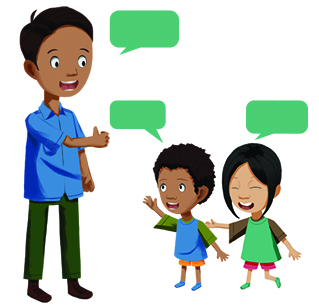Working with children’s first language(s)
- Working with children who speak Indigenous languages/dialects
- Partnering with family and community
- Working with children’s first language(s)
- Understanding the local context
- The impact of Australia’s history on Indigenous languages
- Resources
- Building on Indigenous children’s strengths
- Which Indigenous languages are spoken where?
- Mapping Indigenous languages
- Traditional languages
- New contact languages
- Englishes
- What is a dialect?
- How children learn Standard Australian English as an additional language or dialect
- A day in the life of …
- The difference between language and literacy learning
- The role of language in learning
- Bilingual schools
- Setting up for success
Young Indigenous children benefit from using their first languages in preschool, whether these are traditional languages, new contact languages or Aboriginal and Torres Strait Islander varieties of English.
Children’s first languages are the easiest way for them to talk about their feelings, experiences and ideas. Preventing children from speaking their first languages has a negative impact.
How you work children’s first languages into the preschool program will depend on who else speaks their languages.

If you speak the same language(s) as the children…
Fantastic! Be sure you spend time talking with the children in their first languages, as you will be promoting their intellectual and social-emotional development. You are also well-placed to encourage children in their early learning of additional languages such as SAE.
Here are some ideas for how to do this:
- Consistently talk to the children in their first language.
- Read to children from books written in their first language, or get together with mums, dads and community members to have a go at translating some children’s books.
- Always scribe what children say about their artworks or sandpit creations in their first language (with a translation into English if you like).
- Model using two or more languages in front of the children.
- Talk about speaking and learning languages during activities: ‘We say X in Kriol, Miss Julie says Y in English’.
- Explain English content (when people talk or read stories) in children’s first language.
- Reassure children that it takes time to understand everything English speakers say.
- Encourage children to practise the English they’ve heard in planned activities.
- Tell them that strong and proud Indigenous kids can learn to speak SAE (or school English) as well as they speak their home language/s.
- Explain how they can always speak their family language with their family and friends who speak it, and they can learn SAE and other languages to talk with other people.
Support your colleague to talk with the children in their first languages. Let them know how important it is for the children to use their first languages and how much you value your colleague’s language skills.
Here are some ideas for how to do this:
- Plan the day together so your colleague gets to spend more quality time talking with the children.
- If your colleague agrees, ask them to interpret your English (instructions, explanations etc) so the children hear you speak English and your colleague speak their first language.
- This also gives the children an opportunity to experience your respect for your colleague’s language knowledge.
- Ask your colleague if they would feel OK teaching you some of the language.
- If you both do this in front of the children they will enjoy helping you.
- This models to the children that you value their language and that language learning is fun – attitudes that will help them with learning SAE.

Consider whether any of the children speak the same languages – encourage them to play together or sit together for some time each day.
Build a relationship with the children’s families. Perhaps somebody might be able to spend some time playing with the child/children, and also be available for passing on any messages or explanations about what’s happening that day. (You might find that somebody would be interested in pursuing training as an early childhood educator.)
You might be able to approach a community organisation, such as the local school, council, or health centre for bilingual assistance. What about Aboriginal and Torres Strait Islander organisations?